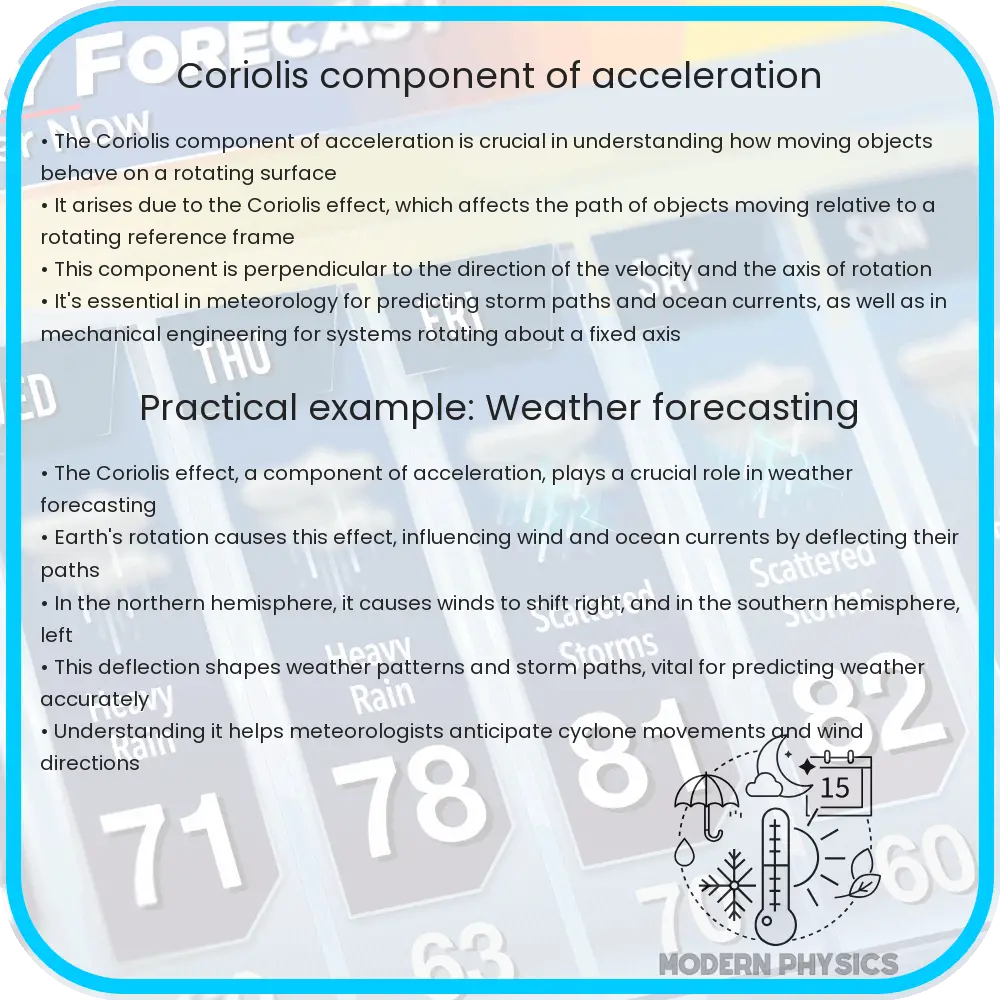Explore the significance of Coriolis acceleration in dynamics, its impact on global phenomena, and applications in science and engineering.

Understanding Coriolis Acceleration in Dynamics
Coriolis acceleration plays a pivotal role in the field of dynamics, particularly when analyzing motion and the forces in a rotating frame of reference. This concept, named after the French scientist Gaspard-Gustave de Coriolis, is crucial in understanding various phenomena in geophysics, oceanography, and mechanical engineering. To fully appreciate its significance, we must delve into its definition, derivation, and practical applications.
Defining Coriolis Acceleration
Coriolis acceleration arises when an object is in motion within a rotating frame of reference. It is an apparent acceleration that occurs due to the rotation of the Earth or any other rotating system. Mathematically, it is expressed as:
ac = 2(ω x v)
where ac represents the Coriolis acceleration, ω is the angular velocity of the rotating frame, and v is the velocity of the object relative to the rotating frame. The symbol x denotes the cross product, indicating that Coriolis acceleration is perpendicular to both the angular velocity and the object’s velocity.
Derivation and Principles
The derivation of Coriolis acceleration stems from the kinematics of a rotating frame of reference. When an object moves in a non-inertial, rotating frame, its motion appears to deviate from a straight path. This deviation is not due to any real force acting on the object but is a result of the frame’s rotation. The Coriolis effect is most commonly observed on a global scale, where the rotation of the Earth influences wind patterns and ocean currents.
Applications in Real-World Scenarios
One of the most significant applications of Coriolis acceleration is in meteorology. It plays an essential role in understanding and predicting weather patterns and atmospheric phenomena. For instance, it helps explain the formation of cyclones, where air movement is deflected due to the Earth’s rotation, causing the characteristic spiral motion of these systems.
Similarly, in oceanography, Coriolis acceleration aids in understanding ocean currents and their dynamics. The movement of water in the Earth’s oceans is significantly influenced by this effect, leading to the formation of large-scale ocean gyres and affecting climate patterns.
In mechanical engineering, Coriolis acceleration is vital in the design and analysis of rotating machinery. Engineers must account for these forces to ensure the stability and proper functioning of equipment like turbines, centrifuges, and gyroscopes.
This concept also finds application in the field of ballistics, where the trajectory of a projectile is influenced by the Earth’s rotation, especially over long distances.
In summary, Coriolis acceleration is a fundamental concept in dynamics, providing insight into the behavior of objects in a rotating frame of reference. Its understanding is crucial for various scientific and engineering disciplines, enabling accurate predictions and efficient designs in the context of a rotating Earth and other systems.
Challenges and Considerations in Applying Coriolis Acceleration
Despite its widespread applications, working with Coriolis acceleration presents unique challenges. Accurately calculating and predicting its effects requires a deep understanding of rotational dynamics and vector calculus. In practical scenarios, such as in aircraft navigation and missile guidance systems, these calculations become crucial for accuracy. The Coriolis effect must be accounted for to ensure precise targeting and navigation over long distances, especially near the Earth’s poles where its effects are more pronounced.
Coriolis Acceleration in Everyday Life
Coriolis acceleration also has subtle but interesting manifestations in everyday life. For instance, it’s a popular myth that the Coriolis effect determines the direction in which water drains in sinks and toilets. While theoretically true, in reality, the effect is too small to influence such small-scale water movements significantly, which are instead governed by the shape and direction of the water container.
Global Implications of the Coriolis Effect
On a global scale, the Coriolis effect is integral to climate science and environmental studies. It influences global wind patterns, which in turn affect weather systems and climate zones. Understanding these patterns is vital for predicting weather changes, studying climate change, and preparing for natural disasters like hurricanes and typhoons, which are directly influenced by Coriolis forces.
Education and Research
In educational settings, the study of Coriolis acceleration is an excellent introduction to non-inertial reference frames and rotational dynamics. It bridges the gap between basic physics concepts and more complex dynamics, providing students with a practical understanding of a phenomenon that impacts our world significantly.
Continued research in this field also opens up possibilities for advancements in technology and science. As our understanding deepens, we can develop more sophisticated models to predict and harness the power of natural phenomena influenced by Coriolis acceleration.
Conclusion
Coriolis acceleration, a fundamental concept in the field of dynamics, offers significant insights into the forces and motions within a rotating frame of reference. From influencing global weather patterns to impacting mechanical engineering designs, its applications are vast and varied. While it presents unique challenges in calculation and application, understanding the Coriolis effect is essential for advancements in various scientific and engineering fields. As we continue to explore and understand this phenomenon, it remains a key factor in shaping our understanding of the natural world and the complex interactions within it. Thus, Coriolis acceleration is not just a theoretical concept, but a practical tool that enhances our ability to navigate, predict, and innovate in a world that is constantly in motion.
